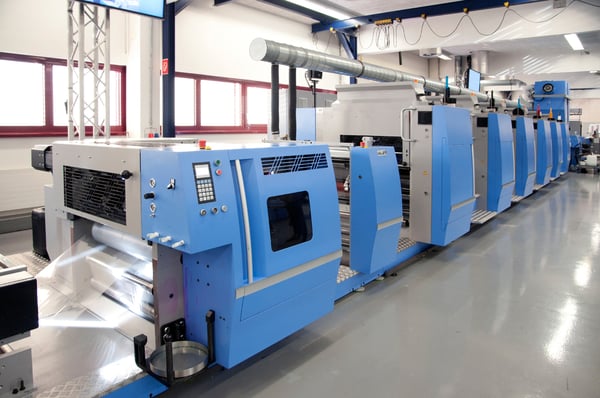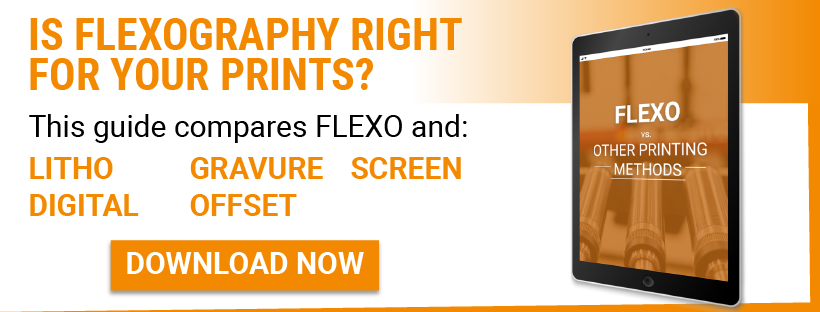Share this
Hybrid Printing Systems: What Are They, & Are They Right for You?
by Luminite on Aug 7, 2020 8:43:16 AM

As we note in many of our posts, today’s flexible packaging does more than protect products. It’s also one of the best ways to market products and brands.
If you want to knock the socks off your customers, then a high-quality print job is a no-brainer! But how do you get that top-notch print?
There are many print technologies to choose from, but hybrid printing is emerging as one of the best. It’s a process that brings the best of both worlds, combining a flexo printing machine with digital technology to produce the highest-quality prints possible.
Read on to learn more about hybrid printing and how it compares to more traditional alternatives.
Digital vs. Flexo Printing: Not Really a Fight
Hybrid printing is growing in popularity as a technological advancement for the digital flexo printing machine.
That’s because hybrid printing takes the advantages of both conventional flexo and digital printing and combines them into a match made in heaven.
In general, flexo is great for large print runs because it’s:
- Fast and simple
- Clean and precise
- Cost-effective
Flexo also works with all kinds of substrates, from flexible plastic film to corrugated board. Not to mention, flexo allows for a variety of finishing options to further enhance the shelf appeal of flexible packaging printing.
Advantages of Hybrid Printing Systems
Hybrid printing offers lots of additional advantages over conventional flexo printing, including:
- Faster production times on short print runs
- Tools cost less, less waste is produced, and setup time is lower
- Job pre-processing and processing times are lower
- Higher profit margin per job
Hybrid is especially useful for short print runs because it cuts down on waste. Conventional flexo operates via the production of photopolymer plates or elastomer sleeves, and it might be costly to produce those image carriers for only a small print run.
Hybrid printing gets around this issue by printing without the plates. This means that you’ll be able to create a much more diverse array of printed products to meet customer needs — all at a reduced cost and with shorter production times. That’s an important feature today in an industry where individual needs are becoming ever more personalized.
Which to Choose: Flexo, Digital, or Hybrid Printing Systems?
Within the realm of flexible packaging printing, digital has long been regarded as a great choice for short runs and test prints. This is because unlike flexo printing, digital doesn’t require plates. It also produces a high quality print.
However, while it’s more economical to use digital for short print runs, on bigger jobs flexo is still the standard. With digital, you do save money on plate production in the short term, but digital assets cost more than flexo presses, and digital costs more to run.
Enter hybrid printing machines. This is the best of both worlds, combining the economy of flexo printing with the automation of digital.
The automation of the process is the real time-saver. When one job finishes, the next can immediately begin. Hybrid machines often include several features that create a faster workflow, such as:
- A variety of advanced customization features like print settings that can be pre-programmed prior to the run and activated with a button press
- Automated labeling, finishing, coating, cutting and packaging, which reduces staffing costs and print times
- Consolidated production since hybrid printing allows you to convert, decorate, and finish products in one pass
Along with these benefits, hybrid systems feature expanded color ranges and facilitate the use of special inks. Greater quality, greater versatility -- what’s not to love about hybrid printing?
Keeping ROI High
Upfront, hybrid printing is a pricey investment. But, to retain a healthy return on investment, it's important that you integrate certain accessories into the printing platform. For instance, use:
- A custom retrofitted system,
- The right type of anilox rolls
- Inkjet ink and toner
- Elastomer sleeves
All of this gear ensures a high-quality print job while using hybrid presses, and are crucial to maintaining quality while improving efficiency.
Maximize Your Pressroom With Digital Flexo Printing
Most package printers still view digital printing as a complement to the more popular flexographic printing, but that’s changing.
The hybrid printing machine is able to combine the best of both of these printing technologies into one format, something that can be very attractive to printers looking to take their operations to the next level.
And as you’re progressing in your printing journey, use this guide to learn more about the differences between printing methods!
Share this
- Flexographic Printing (81)
- Image Carrier (28)
- Elastomer sleeves (27)
- Ink Transfer (25)
- Quality (22)
- Flexo sleeve (20)
- News (18)
- printing defects (18)
- flexo printing defects (17)
- sustainability (13)
- Flexo Troubleshooting (12)
- Ink (12)
- Digital Printing (10)
- Flexo 101 (10)
- Flexo Inks, (9)
- Anilox (7)
- Blister Packaging (7)
- Cost (6)
- print misregistration (6)
- regulations (6)
- Corrugated Printing (4)
- pinholing (4)
- "Tradeshow (3)
- Digital Flexo (3)
- Gravure Printing (3)
- Insider (3)
- Load-N-Lok (3)
- Wide Web (3)
- direct laser engraving (3)
- flexo-equipment-accessories (3)
- gear marks (3)
- halo (3)
- testing (3)
- Narrow Web (2)
- bridging (2)
- feathering (2)
- filling in (2)
- mottled image (2)
- pressure (2)
- Labelexpo (1)
- dirty prints (1)
- doughnuts (1)
- embossing (1)
- kiss impression (1)
- October 2023 (2)
- September 2023 (1)
- August 2023 (1)
- July 2023 (3)
- June 2023 (1)
- May 2023 (5)
- April 2023 (1)
- March 2023 (2)
- February 2023 (1)
- January 2023 (3)
- December 2022 (1)
- October 2022 (3)
- September 2022 (2)
- August 2022 (2)
- July 2022 (3)
- May 2022 (1)
- April 2022 (4)
- March 2022 (2)
- February 2022 (5)
- January 2022 (7)
- December 2021 (1)
- November 2021 (3)
- October 2021 (2)
- September 2021 (1)
- August 2021 (1)
- July 2021 (3)
- June 2021 (1)
- May 2021 (4)
- April 2021 (4)
- March 2021 (4)
- February 2021 (2)
- December 2020 (1)
- November 2020 (1)
- October 2020 (2)
- September 2020 (1)
- August 2020 (3)
- July 2020 (2)
- June 2020 (3)
- May 2020 (1)
- April 2020 (1)
- November 2019 (3)
- October 2019 (1)
- August 2019 (1)
- July 2019 (1)
- April 2019 (1)
- March 2019 (1)
- January 2019 (1)
- October 2018 (2)
- August 2018 (1)
- July 2018 (1)
- June 2018 (1)
- February 2018 (2)
- October 2017 (1)
- September 2017 (2)
- January 2016 (1)
- February 2015 (1)
- January 2015 (1)
- December 2014 (2)
- September 2014 (1)
- February 2014 (1)
- January 2014 (1)
- December 2013 (3)
- October 2013 (1)
- September 2013 (1)
- June 2013 (1)
- January 2013 (1)


No Comments Yet
Let us know what you think